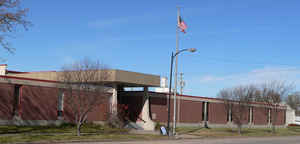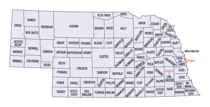Nebraska Counties
There is ninety-three counties in state of Nebraska. Despite the fact that Sarpy County contained the oldest settlement in the state, it was one of the last lands along the river to be recognized by law. Finally, on February 1, 1857, the land "where the cities meet the country" was officially created.Buffalo County, Nebraska
Buffalo County Education, Geography, and History
Buffalo County is a county located in the state of Nebraska. Based on the 2010 census, the population was 46,102, making it the
fifth-most populous county in Nebraska. Its county seat is Kearney. The county was created in 1855 and later organized in 1870.It was named
after the then-prevalent buffalo herds.
Buffalo County is part of the Kearney, NE Micropolitan Statistical Area.
Etymology - Origin of Buffalo County Name
Buffalo County is one of only two counties in Nebraska that derived its name from an animal. Years before this area along the Platte River would become a county, large herds of buffalo grazed the river valley and the rolling plains to the north. When it came time to organize the county, it seemed fitting to name it after the animal that once roamed the area freely.
Demographics:
County QuickFacts: CensusBureau Quick Facts
Buffalo County History
The boundaries of Buffalo County were
established by the Territorial Legislature in 1855. The county was officially
organized in 1864, three years before Nebraska was admitted to the Union.
Two transportation lines can be credited with the early development of the area
-- the Mormon Trail and the Union Pacific Railroad.
The first settlers in this area were said to be Mormons who had headed west
along the trail in 1858. But a fierce war between the Cheyenne and Sioux tribes
forced these early settlers to temporarily abandon the area. When the fighting
subsided, the settlers gradually returned. In time, more and more settlers came
to the area because of the rich Platte River Valley and the fertile soil that
could be found in the surrounding hills.
With the coming of the railroad in the 1860s, Buffalo County would continue to
develop. One of the stations that sprang up was Kearney, the county seat.
Originally named Fort Childs, it was later renamed Kearney Junction and finally
shortened to Kearney. Moses H. Sydenham, one of the early pioneers in the
county, founded a newspaper in this young settlement and used the publication to
promote his idea that Kearney, with its central location, should become the
capital of the United States.
Hardships such as hot, dry weather and severe blizzards were not uncommon for
the early residents of the county. But the most serious challenge faced by those
who worked the land was the damage done by waves of grasshoppers that swarmed
over the area in the mid 1870s.
More than 115 years later, Buffalo County is a thriving agricultural and
industrial area. It also plays an important role in the state's higher education
system, with the University of Nebraska-Kearney located in the county seat.
Geography: Land and Water
As reported by the Census Bureau, the county has a total area of 875 square miles (2,270 km2), of which 968 square miles (2,510 km2) is land and 7.3 square miles (19 km2) (0.7%) is water
Neighboring Counties
Bordering counties are as follows:
- Hall County, Nebraska (east)
- Adams County, Nebraska (southeast)
- Kearney County, Nebraska (south)
- Phelps County, Nebraska (southwest)
- Dawson County, Nebraska (west)
- Custer County, Nebraska (northwest)
- Sherman County, Nebraska (north)
- Howard County, Nebraska (northeast)
Education







